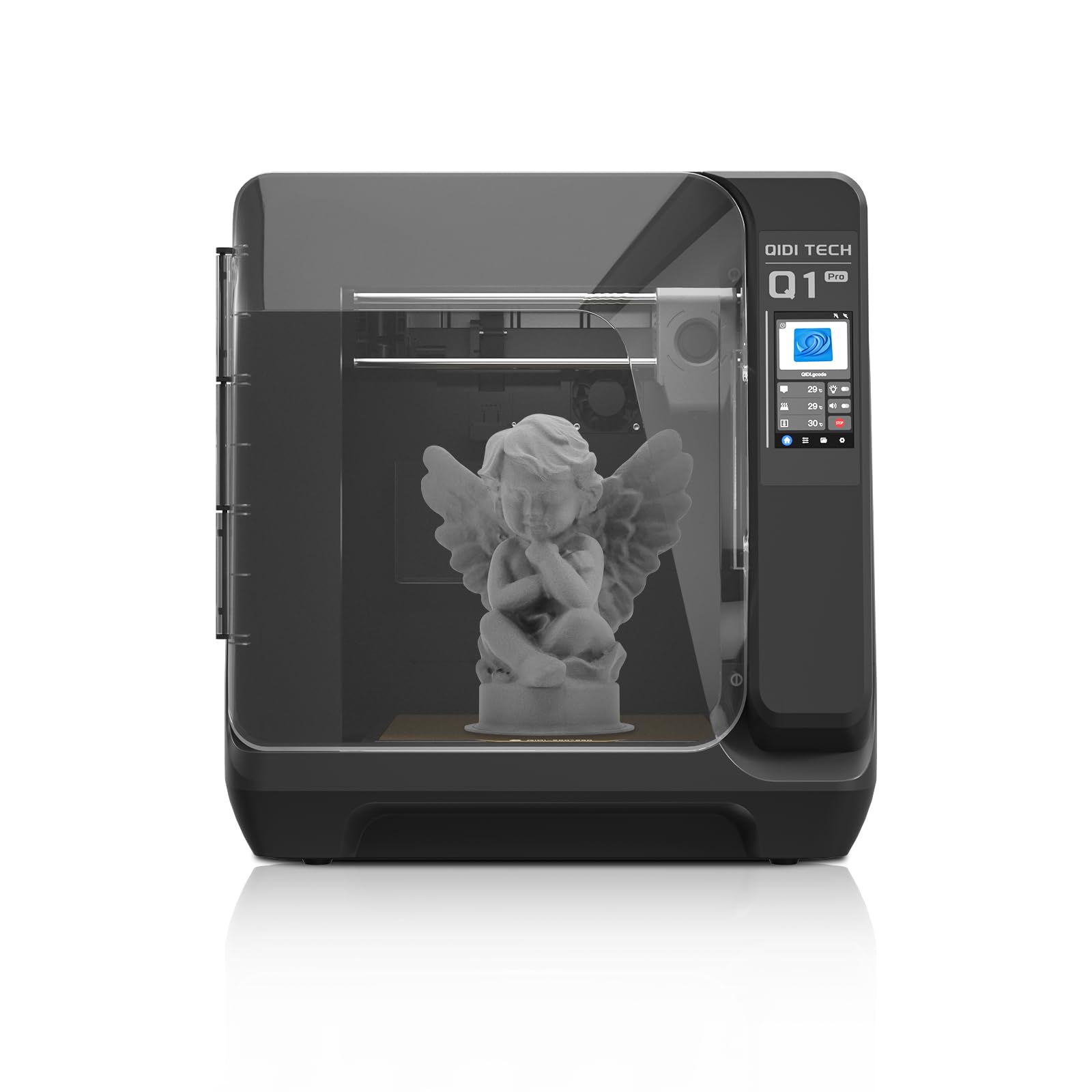Compare K1 Max vs Q1 PRO
Comparison between the best 3D printers
Choose the best 3D printer at the best price. The cheapest 3D printers are here.
Buy a 3D printer here with 3D Fila.
 |
 |
|
| Model | K1 Max[BUY K1 Max] |
Q1 PRO[BUY Q1 PRO] |
| Printing Material | Filament | Filament |
| Buy Filament for Creality 3D K1 Max | Buy Filament forQIDI Q1 PRO | |
| Estimated price | $1300,00 | $449,00 |
| Manufacturer | Creality 3D | QIDI |
| Release Year | 2023 | 2024 |
| Print Volume [mm] | 300x300x300 | 245x245x245 |
| Printer Size [mm] | 435x462x526 | 467x477x489 |
| Weight [kg] | 18 | 20 |
| Power Loss Recovery | YES | YES |
| Enclosed printer | YES | YES |
| Bed Leveling | Automatic | Automatic |
| Filament End Sensor | YES | YES |
| Bed type | Heated | Heated |
| Power supply system | Direct Drive | Direct Drive |
| Standard nozzle | 0,4 | 0,4 |
| Maximum Nozzle Temperature [°C] | 300 | 350 |
| Maximum Bed Temperature [°C] | 100 | 120 |
| Maximum printing speed [mm/s] | 600 | 600 |
| Filament holder | YES | YES |
| Camera for supervision | YES | YES |
| Recommended filaments | ABS, PLA, PETG, TPU, PA, ASA, PC, PLA-CF, PA-CF, PET-CF | PLA、ABS、ASA、PETG、TPU、PC、PA、PA-CF、PET-CF、PAHT-CF etc. |
| Recommended slicers | Creality Print, Cura, Simplify, Slic3r, IdeaMaker e outros | QIDI Slicer/Cura/Simplify 3D/ORCA/PRUSA Slicer |
| Maximum Resolution [mm] | 0,1 | 0,1 |
| Processor | Cortex-A53,64-bit Processor | |
| Display | Display touchscreen 4,3'' | Touchscreen 4,3'' |
| Power Supply | 350 W | |
| Connectivity | USB / Wi-Fi / Ethernet | WiFi/USB Flash Drive/Ethernet Cable |
| Operating systems | Windows, Mac, Linux | Windows, Linux, Macbook |
| Date of registration in the system | 2023-12-01 | 2024-07-09 |
| Release date | 2023 | 2024 |
| Extra features | The Creality K1 Max stands out as a fast Core XY 3D printer with a large build volume of 300 x 300 x 300 mm. It is fully enclosed and equipped with AI sensors to prevent print failures. This model has a smooth and flexible PEI build platform, and uses an automatic leveling system with LIDAR, as well as a filament run-out sensor. LAN, Creality Cloud and USB Flash Disk connectivity are available, as well as a 4.3-inch touchscreen interface. The K1 Max is robust, weighing in at 18 kg, and includes an AI camera and limited version of the Klipper firmware. Its motion system is solid and the printer is efficient with high-temperature filaments, but it is not silent. Assembly is 99% complete, requiring only minor adjustments before use. | The QIDI Q1 Pro 3D printer stands out for its Core XY structure and heating chambers that reach up to 60ºC, ideal for advanced materials such as ABS and Nylon. It features Klipper firmware, an automatic leveling system, a high-flow extruder with a double metal nozzle and a hotend that reaches 350ºC. It offers connectivity via Wi-Fi, USB and Ethernet, as well as a 1080p camera for remote monitoring and an intuitive touchscreen for easy operation. |
| Support for multiple colors and materials (AMS and CFS) | NO | NO |
Notes * |
||
| Cost-benefit | 7 / 10 | 8 / 10 |
| Hardware | 4.8 / 10 | 5.4 / 10 |
| Tela | . | . |
| Print volume | 4 / 10 | 3 / 10 |
| Performance | 5 / 10 | 5 / 10 |
| [BUY K1 Max] | [BUY Q1 PRO] |
Conclusion |
| In conclusion, the comparison between the Creality K1 Max and the QIDI Q1 Pro 3D printers highlights distinct advantages that cater to different user needs and preferences. The K1 Max offers a larger build volume and a robust feature set that includes AI sensors, an advanced automatic leveling system, and excellent compatibility with high-temperature materials, making it suitable for users who prioritize versatility and advanced capabilities in their printing tasks. On the other hand, the QIDI Q1 Pro, while smaller in print volume, provides impressive features such as a hotend that reaches higher temperatures, making it ideal for advanced materials like Nylon and ABS. It also benefits from an intuitive design and Klipper firmware, which appeals to users who prefer a streamlined printing experience. Price is a significant differentiator, with the K1 Max positioned as a premium option offering high performance and advanced technology, while the Q1 Pro provides a cost-effective solution for users who still want a high-quality printing experience but at a lower entry cost. Ultimately, the choice between the two will depend on the user's specific needs—whether they prioritize a larger build space and advanced features or a more budget-friendly option that still offers excellent performance with a sleek operating experience. Both printers score well on cost-benefit ratios, indicating that either model presents a solid investment based on the user’s individual requirements. |

